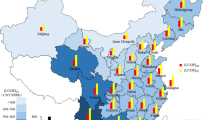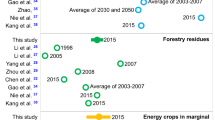Abstract
Bioenergy with Carbon Capture and Storage (BECCS) is a potential technology to help achieve carbon neutrality. Currently, many researchers focus on the contribution of BECCS technology to achieving carbon neutrality but lack consideration of the actual spatial distribution of biomass resource endowments. Taking China's coal power sector, the largest carbon emitter, as an example, this study explores how BECCS technology can help achieve its carbon neutrality and maximize its emission reduction potential based on existing available biomass resources. The results show that all available biomass within 250 km and 100 km of coal power plants is 14.8 EJ and 11.8 EJ, respectively. With this biomass, the BECCS technology can help the coal power sector of China become carbon neutral after retrofitting most of the young generating units (younger than 20 years). After all units are retrofitted, the technology can achieve negative emissions of − 1.26 Gt and − 0.92 Gt, respectively. Furthermore, based on the layout of the biomass supply chain, provinces with better potential for biomass resource utilization are identified. Additionally, over 50% of generator units nationwide have biomass price advantages over coal. These findings provide a positive perspective for the promotion of BECCS technology in China's coal power sector to achieve carbon neutrality or even negative emissions.










Similar content being viewed by others
Data availability
The datasets generated during and/or analyzed during the current study are available from the corresponding author on reasonable request.
References
Baik, E., Sanchez, D. L., Turner, P. A., Mach, K. J., Field, C. B., & Benson, S. M. (2018). Geospatial analysis of near-term potential for carbon-negative bioenergy in the United States. Proceedings of the National Academy of Sciences of the United States of America. https://doi.org/10.1073/pnas.1720338115
Bhave, A., Taylor, R. H., Fennell, P., Livingston, W. R., Shah, N., Mac Dowell, N., Dennis, J., Kraft, M., Pourkashanian, M., Insa, M., & Jones, J. (2017). Screening and techno-economic assessment of biomass-based power generation with CCS technologies to meet 2050 CO2 targets. Applied Energy, 190, 481–489. https://doi.org/10.1016/j.apenergy.2016.12.120
Chen, W., Wu, F., & Zhang, J. (2016). Potential production of non-food biofuels in China. Renewable Energy. https://doi.org/10.1016/j.renene.2015.07.024
Cintas, O., Berndes, G., Englund, O., Cutz, L., & Johnsson, F. (2018). Geospatial supply–demand modeling of biomass residues for co-firing in European coal power plants. GCB Bioenergy. https://doi.org/10.1111/gcbb.12532
Clare, A., Gou, Y. Q., Barnes, A., Shackley, S., Smallman, T. L., Wang, W., Jiang, D., & Li, J. (2016). Should China subsidize cofiring to meet its 2020 bioenergy target? A spatio-techno-economic analysis. GCB Bioenergy, 8(3), 550–560.
Council, C. E. (2021). China electric power statistical yearbook 2020. China Statistics Press.
Eggleston, S., Buendia, L., Miwa, K., Ngara, T., & Tanabe, K. (2006). IPCC guidelines for national greenhouse gas inventories.
Gao, J., Zhang, A., Lam, S. K., Zhang, X., Thomson, A. M., Lin, E., Jiang, K., Clarke, L. E., Edmonds, J. A., Kyle, P. G., & Yu, S. (2016). An integrated assessment of the potential of agricultural and forestry residues for energy production in China. Gcb Bioenergy, 8(5), 880–893. https://doi.org/10.1111/gcbb.12305
Global Energy Monitor. (2020). Global Coal Plant Tracker, July 2020.
Global CCS Institute. (2020). Global Status of CCS Report 2020. Global CCS Institute.
Goerndt, M. E., Aguilar, F. X., & Skog, K. (2013). Drivers of biomass co-firing in U.S. coal-fired power plants. Biomass and Bioenergy. https://doi.org/10.1016/j.biombioe.2013.09.012
Hanssen, S. V., Daioglou, V., Steinmann, Z. J. N., Doelman, J. C., Van Vuuren, D. P., & Huijbregts, M. A. J. (2020). The climate change mitigation potential of bioenergy with carbon capture and storage. Nature Climate Change. https://doi.org/10.1038/s41558-020-0885-y
Hansson, A., Fridahl, M., Haikola, S., Yanda, P., Pauline, N., & Mabhuye, E. (2020). Preconditions for bioenergy with carbon capture and storage (BECCS) in sub-Saharan Africa: The case of Tanzania. Environment, Development and Sustainability, 22(7), 6851–6875. https://doi.org/10.1007/S10668-019-00517-Y/FIGURES/2
He, K., Mi, Z., Zhang, J., Li, J., & Coffman, D. (2023). The polarizing trend of regional CO2 emissions in China and its implications. Environmental Science & Technology. https://doi.org/10.1021/ACS.EST.2C08052
He, Y., Xing, Y., Zeng, X., Ji, Y., Hou, H., Zhang, Y., & Zhu, Z. (2022). Factors influencing carbon emissions from China’s electricity industry: Analysis using the combination of LMDI and K-means clustering. Environmental Impact Assessment Review, 93, 106724. https://doi.org/10.1016/J.EIAR.2021.106724
Huang, X., Chang, S., Zheng, D., & Zhang, X. (2020). The role of BECCS in deep decarbonization of China’s economy: A computable general equilibrium analysis. Energy Economics. https://doi.org/10.1016/j.eneco.2020.104968
IEA. (2020). Energy Technology Perspectives 2020 - Special Report on Clean Energy Innovation. Energy Technology Perspectives 2020.
IPCC. (2018). IPCC report Global warming of 1.5°C. Global Warming of 1.5°C. An IPCC Special Report on the impacts of global warming of 1.5°C above pre-industrial levels and related global greenhouse gas emission pathways, in the context of strengthening the global response to the threat of climate change, 2(October).
Kang, Y., Yang, Q., Bartocci, P., Wei, H., Liu, S. S., Wu, Z., Zhou, H., Yang, H., Fantozzi, F., & Chen, H. (2020). Bioenergy in China: Evaluation of domestic biomass resources and the associated greenhouse gas mitigation potentials. Renewable and Sustainable Energy Reviews, 127, 109842. https://doi.org/10.1016/j.rser.2020.109842
Li, J., Brzdekiewicz, A., Yang, W., & Blasiak, W. (2012). Co-firing based on biomass torrefaction in a pulverized coal boiler with aim of 100% fuel switching. Applied Energy. https://doi.org/10.1016/j.apenergy.2012.05.046
Li, J., Wang, Y., Xu, D., & Xie, K. (2020). High-resolution analysis of life-cycle carbon emissions from China’s coal-fired power industry: A provincial perspective. International Journal of Greenhouse Gas Control. https://doi.org/10.1016/j.ijggc.2020.103110
Liu, Z., Deng, Z., He, G., Wang, H., Zhang, X., Lin, J., Qi, Y., & Liang, X. (2022). Challenges and opportunities for carbon neutrality in China. Nature Reviews Earth & Environment, 3(2), 141–155. https://doi.org/10.1038/s43017-021-00244-x
Lu, X., Cao, L., Wang, H., Peng, W., Xing, J., Wang, S., Cai, S., Shen, B., Yang, Q., Nielsen, C. P., & McElroy, M. B. (2019). Gasification of coal and biomass as a net carbon-negative power source for environment-friendly electricity generation in China. Proceedings of the National Academy of Sciences, 116(17), 8206–8213.
Nie, Y., Chang, S., Cai, W., Wang, C., Fu, J., Hui, J., Yu, L., Zhu, W., Huang, G., Kumar, A., & Guo, W. (2020). Spatial distribution of usable biomass feedstock and technical bioenergy potential in China. Gcb Bioenergy, 12(1), 54–70. https://doi.org/10.1111/gcbb.12651
Nivala, M., Anttila, P., Laitila, J., Salminen, O., & Flyktman, M. (2016). A GIS-based methodology to estimate the regional balance of potential and demand of forest chips. Journal of Geographic Information System. https://doi.org/10.4236/jgis.2016.85052
Pour, N., Webley, P. A., & Cook, P. J. (2018). Opportunities for application of BECCS in the Australian power sector. Applied Energy. https://doi.org/10.1016/j.apenergy.2018.04.117
Rosa, L., Sanchez, D. L., & Mazzotti, M. (2021). Assessment of carbon dioxide removal potential: Via BECCS in a carbon-neutral Europe. Energy and Environmental Science. https://doi.org/10.1039/d1ee00642h
Schakel, W., Meerman, H., Talaei, A., Ramírez, A., & Faaij, A. (2014). Comparative life cycle assessment of biomass co-firing plants with carbon capture and storage. Applied Energy. https://doi.org/10.1016/j.apenergy.2014.06.045
Selosse, S., & Ricci, O. (2014). Achieving negative emissions with BECCS (bioenergy with carbon capture and storage) in the power sector: New insights from the TIAM-FR (TIMES Integrated Assessment Model France) model. Energy. https://doi.org/10.1016/j.energy.2014.09.014
Tang, B., Li, R., Yu, B., An, R., & Wei, Y.-M. (2018). How to peak carbon emissions in China’s power sector: A regional perspective. Energy Policy, 120, 365–381.
Wang, R., Chang, S., Cui, X., Li, J., Ma, L., Kumar, A., Nie, Y., & Cai, W. (2021). Retrofitting coal-fired power plants with biomass co-firing and carbon capture and storage for net zero carbon emission: A plant-by-plant assessment framework. GCB Bioenergy, 13(1), 143–160. https://doi.org/10.1111/gcbb.12756
Wang, S., Huang, X., Yin, C., & Richel, A. (2021b). A critical review on the key issues and optimization of agricultural residue transportation. Biomass and Bioenergy, 146, 105979.
Weng, Y., Cai, W., & Wang, C. (2021). Evaluating the use of BECCS and afforestation under China’s carbon-neutral target for 2060. Applied Energy. https://doi.org/10.1016/j.apenergy.2021.117263
Xing, X., Wang, R., Bauer, N., Ciais, P., Cao, J., Chen, J., Tang, X., Wang, L., Yang, X., Boucher, O., & Goll, D. (2021). Spatially explicit analysis identifies significant potential for bioenergy with carbon capture and storage in China. Nature communications, 12(1), 3159. https://doi.org/10.1038/s41467-021-23282-x
Yang, B., Wei, Y. M., Hou, Y., Li, H., & Wang, P. (2019). Life cycle environmental impact assessment of fuel mix-based biomass co-firing plants with CO2 capture and storage. Applied Energy. https://doi.org/10.1016/j.apenergy.2019.113483
Yang, X., Nielsen, C. P., Song, S., & McElroy, M. B. (2022). Breaking the hard-to-abate bottleneck in China’s path to carbon neutrality with clean hydrogen. Nature Energy, 7(10), 955–965. https://doi.org/10.1038/s41560-022-01114-6
Yang, Y., Zhang, P., Zhang, W., Tian, Y., Zheng, Y., & Wang, L. (2010). Quantitative appraisal and potential analysis for primary biomass resources for energy utilization in China. Renewable and Sustainable Energy Reviews. https://doi.org/10.1016/j.rser.2010.07.054
Zhao, G. (2018). Assessment of potential biomass energy production in China towards 2030 and 2050. International Journal of Sustainable Energy. https://doi.org/10.1080/14786451.2016.1231677
Zhao, X., Ma, X., Chen, B., Shang, Y., & Song, M. (2022). Challenges toward carbon neutrality in China: Strategies and countermeasures. Resources, Conservation and Recycling, 176, 105959. https://doi.org/10.1016/J.RESCONREC.2021.105959
Zhao, Y., Su, Q., Li, B., Zhang, Y., Wang, X., Zhao, H., & Guo, S. (2022). Have those countries declaring “zero carbon” or “carbon neutral” climate goals achieved carbon emissions-economic growth decoupling? Journal of Cleaner Production, 363, 132450. https://doi.org/10.1016/J.JCLEPRO.2022.132450
Acknowledgments
Our sincere gratitude also goes to the anonymous reviewers and in particular to colleagues in our research team for their hard work on this challenging project.
Funding
This work was supported by National Natural Science Foundation of China (grant numbers 72104025, 72293600 and 72293605), and the China’s National Key R&D Program (grant number 2022YFE0206800).
Author information
Authors and Affiliations
Corresponding author
Ethics declarations
Conflict of interest
The authors declare that they have no known competing financial interests or personal relationships that could have appeared to influence the work reported in this paper.
Additional information
Publisher's Note
Springer Nature remains neutral with regard to jurisdictional claims in published maps and institutional affiliations.
Appendix
Rights and permissions
Springer Nature or its licensor (e.g. a society or other partner) holds exclusive rights to this article under a publishing agreement with the author(s) or other rightsholder(s); author self-archiving of the accepted manuscript version of this article is solely governed by the terms of such publishing agreement and applicable law.
About this article
Cite this article
Zhang, YL., Kang, JN., Dai, M. et al. The role of BECCS technology in achieving carbon neutrality: evidences from China’ coal power sector. Environ Dev Sustain (2023). https://doi.org/10.1007/s10668-023-03842-5
Received:
Accepted:
Published:
DOI: https://doi.org/10.1007/s10668-023-03842-5




